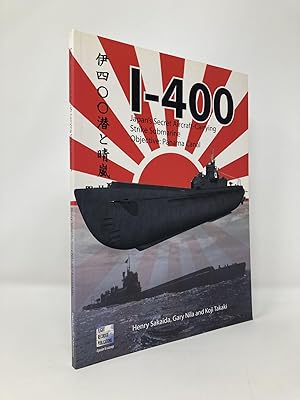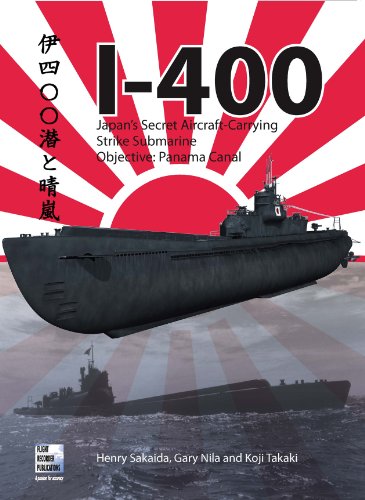9780955426810 - I-400: Japan's Secret Aircraft-Carrying Strike Submarine: Objective Panama Canal de Sakaida, Henry; Nila, Gary; Koji, Takaki (2 résultats)
Type d'article
- Tous les types de produits
- Livres (2)
- Magazines & Périodiques
- Bandes dessinées
- Partitions de musique
- Art, Affiches et Gravures
- Photographies
- Cartes
- Manuscrits & Papiers anciens
Etat
Reliure
- Toutes
- Couverture rigide
- Couverture souple (2)
Particularités
Livraison gratuite
- Frais de port gratuits USA
Pays
Evaluation du vendeur
-
I-400: Japan's Secret Aircraft-Carrying Strike Submarine: Objective Panama Canal
Edité par Hikoki Publications, 2010
ISBN 10 : 0955426812ISBN 13 : 9780955426810
Vendeur : Southampton Books, Southampton, NY, Etats-Unis
Livre
Trade Paperback. Etat : Like New. 2nd Edition, First Printing. Not price-clipped ($19.95 price intact). Published by Crecy, 2010. Quarto. Pictorial wraps. Book is like new; clean with no writing or names. Sharp corners and spine straight. Binding tight and pages crisp. A fine copy of this guide to the Japanese 1-400 submarines and their planned missions in WWII. 112 pages. ISBN: 9780955426810. 100% positive feedback. 30 day money back guarantee. NEXT DAY SHIPPING! Excellent customer service. Please email with any questions or if you would like a photo. All books packed carefully and ship with free delivery confirmation/tracking. All books come with free bookmarks. Ships from Southampton, New York. We Buy Books! Individual titles, libraries, collections. Message us if you have books to sell!.
-
I-400; Japan's Secret aircraft-carrying Strike Submarine Objective: Panama Canal
Edité par Crecy Publishing Limited, Manchester, 2010
ISBN 10 : 0955426812ISBN 13 : 9780955426810
Vendeur : Ground Zero Books, Ltd., Silver Spring, MD, Etats-Unis
Livre Edition originale
Trade paperback. Etat : Very good. Etat de la jaquette : No dust jacket issued. Kyodhi Harada, Harry Whitver, and Tim Brown (illustrateur). Format is approximately 7.75 inches and 10.5 inches. 112 pages. Illustrations (some with color). Bibliography. Index. Foreword by Kazuo Takahashi. Foreword by Joseph M. McDowell. The I-400 class was the brainchild of Admiral Isoroku Yamamoto, Commander-in- Chief of the Japanese Combined Fleet. Shortly after the attack on Pearl Harbor, he conceived the idea of taking the war to the United States mainland by making aerial attacks against cities along the U.S. western and eastern seaboards using submarine-launched naval aircraft. He commissioned Captain Kameto Kuroshima to make a feasibility study. Construction of I-400 commenced at Kure Dock Yards on 18 January 1943. Following an inspection of Rabaul in August 1943, Captain Chikao Yamamoto and Commander Yasuo Fujimori conceived the idea of using the sen toku (secret submarine attack) to destroy the locks of the Panama Canal in an attempt to cut American supply lines to the Pacific Ocean and hamper the transfer of U.S. ships. Intelligence gathering on the proposed target began later that year. The Japanese conceived of an attack on the United States through the use of biological weapons specifically directed at the civilian population in San Diego, California. Dubbed "Operation Cherry Blossoms at Night", the plan was to launch aircraft from five I-400 submarines at night, who would then drop "infected flea" bombs on the intended target, in the hope that the resulting infection would spread to the entire Western seaboard and kill tens of thousands of people. Japan surrendered before the operation was carried out. The I-400 submarine was one of the most monstrous creations to emerge from World War II and, in its time, it was the largest submarine ever built. At more than 400 feet long, weighing 5,223 tons submerged, carrying a crew of nearly 200 and possessing a range of over 30,000 nautical miles, the I-400 featured state of the art Japanese radar and 'stealth' technology and carried three Aichi M6A Seiran attack floatplanes in a water-tight tube-like hangar built onto the deck forward of and under its massive conning tower. In mid-1944 this secret weapon was tasked with attacking American cities and destroying the Panama Canal. The extraordinary story of this submarine is told using first-hand accounts from three of the original air crew assigned to fly the Seirans and former officers and crew of the I-400 as well as American naval personnel who crewed the vessel on its dramatic final voyage. Hundreds of remarkable photographs show external and internal views of the I-400. The I-400-class submarine Imperial Japanese Navy (IJN) submarines were the largest submarines of World War II and remained the largest ever built until the construction of nuclear ballistic missile submarines in the 1960s. The IJN called this type of submarine Sentoku type submarine. The type name was shortened to Toku-gata Sensuikan. They were submarine aircraft carriers able to carry three Aichi M6A Seiran aircraft underwater to their destinations. They were designed to surface, launch their planes, then quickly dive again before they were discovered. They also carried torpedoes for close-range combat. The I-400 class was designed with the range to travel anywhere in the world and return. A fleet of 18 boats was planned in 1942, and work started on the first in January 1943 at the Kure, Hiroshima arsenal. Within a year the plan was scaled back to five, of which only three (I-400 at Kure, and I-401 and I-402 at Sasebo) were completed. First Edition this publisher [stated]. Presumed first printing.



